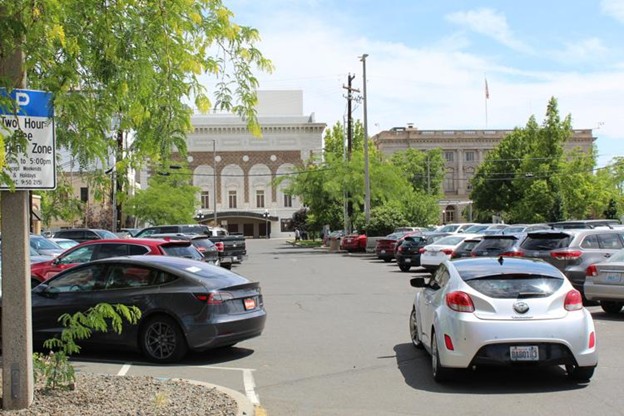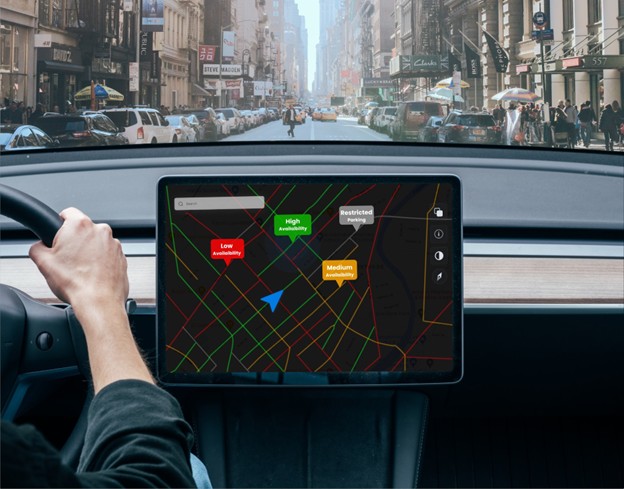
We’ve all been there – circling the block repeatedly in search of an elusive parking spot. It’s frustrating, time-consuming, and as it turns out, remarkably damaging to our environment. This seemingly innocuous daily ritual is actually a significant contributor to urban carbon emissions and represents a climate challenge hiding in plain sight across America’s cities, both large and small.
The Surprising Scale of the Problem
The environmental impact of searching for parking is far more substantial than most people realize.
- In major urban areas, between 30-40% of all congestion is caused by drivers looking for parking spaces. This isn’t just an inconvenience—it translates directly into increased fuel consumption and unnecessary greenhouse gas emissions.
- In the United States alone, vehicles searching for parking waste approximately 930 million gallons of gasoline annually.
- This results in the production of 18.6 billion pounds of carbon dioxide emissions each year—equivalent to the electricity-related emissions of 1.25 million homes.
- Globally, the search for parking burns through about one million barrels of oil every single day.
These statistics reveal a startling truth: a significant portion of our urban carbon footprint comes not from necessary travel, but from the inefficient process of finding a place to park once we’ve reached our destination.
→ Learn how Parknav’s predictive parking technology reduces search times by up to 43%
A Local Perspective

To understand the impact on a more tangible scale, consider the case study of Westwood Village neighborhood in Los Angeles. Research conducted by parking policy expert Donald Shoup found that cruising for parking in this single neighborhood creates approximately 950,000 excess vehicle miles traveled per year.
Now imagine this scenario playing out in thousands of downtown areas across America—from major metropolitan regions to growing small cities like Celina, Texas, or Davidson, North Carolina. In communities experiencing rapid growth, where infrastructure struggles to keep pace with population increases, the parking search problem often intensifies as more vehicles compete for limited spaces.
→ See how Parknav has helped small cities improve parking efficiency
The Personal and Collective Impact
On an individual level, eliminating the search for parking could reduce a single driver’s carbon footprint by 227kg of greenhouse gases annually. While this might seem modest in isolation, the collective impact across millions of drivers is substantial.
The environmental cost extends beyond just carbon emissions.
- Additional congestion contributes to particulate matter pollution, affecting air quality
- Increased noise pollution in urban areas
- Higher stress levels for drivers
- Lost productivity from time wasted searching
None of these external costs are reflected in the price of parking itself, making this an invisible burden on our communities and environment.
Small Cities, Big Opportunity

For America’s growing small cities, addressing parking inefficiency represents a significant opportunity to reduce their carbon footprint while improving quality of life. Towns like Dublin, Ohio, and Pickerington, Ohio, are already discovering that smart parking solutions can simultaneously address congestion, improve downtown accessibility, and contribute to sustainability goals.
In Davidson, North Carolina, improvements in parking management led to a 30% increase in parking space utilization efficiency. This means fewer cars circling and more drivers finding spaces promptly—a win for both convenience and carbon reduction. When multiplied across hundreds of similar communities nationwide, these improvements could significantly reduce unnecessary emissions.
→ Explore Parknav’s small city success stories
Technology as a Climate Solution
The good news is that solutions to this problem already exist and are being implemented in forward-thinking communities. Smart parking systems use sensors, data analytics, and mobile applications to guide drivers directly to available spaces, eliminating the need to circle endlessly.
Key benefits of smart parking technology:
- Reduce searching time by up to 43% and parking-related congestion by up to 30%.
- Real-time parking availability information, integrated into navigation apps or dedicated parking platforms, allows drivers to make informed decisions before they even begin their journey.
- Some systems even enable drivers to reserve spaces in advance, further reducing uncertainty and unnecessary driving.
- Dynamic pricing structures, where parking rates adjust based on demand, can also help distribute vehicles more efficiently across available spaces.
When implemented thoughtfully, these systems can ensure that there are always some spaces available, virtually eliminating the need to circle.
Beyond Technology: Rethinking Urban Space

While technology offers immediate solutions, addressing parking-related emissions also requires us to reconsider how we allocate and manage urban space. Many cities are implementing comprehensive parking management strategies that include:
Creating pedestrian-friendly downtowns that encourage walking between destinations once parked Improving public transit options to reduce the need for parking altogether Developing shared parking arrangements between businesses with different peak hours Redesigning parking layouts to maximize efficiency and capacity
These approaches recognize that the most environmentally friendly parking space is the one that’s found quickly—or not needed at all.
→ Discover how Parknav integrates with comprehensive urban planning
The Road Ahead
As we confront the urgent challenge of climate change, we must address emissions from all sources—including those that might seem trivial at first glance. The carbon impact of searching for parking is substantial enough to warrant serious attention from urban planners, policymakers, and technology developers.
For growing communities, particularly small cities experiencing rapid development, integrating smart parking solutions into their infrastructure planning represents a relatively straightforward way to reduce emissions while improving quality of life. By making it easier to find parking, these cities can reduce congestion, support local businesses, and contribute to climate goals simultaneously.
The next time you find yourself circling the block in search of parking, remember that this frustrating ritual isn’t just consuming your time—it’s also consuming fossil fuels and producing emissions that affect our shared environment. By supporting and advocating for smarter parking solutions in our communities, we can help eliminate this hidden source of carbon emissions and create more livable, sustainable cities for everyone.
Andy Ramm is the Chief Product Officer at Parknav
Want to learn more?
Let’s talk parking…and much more !

We’d love to answer all your questions
Let us know how we can help solve all of your parking needs, parking restrictions, traffic control, smart city information….or just say hi !


